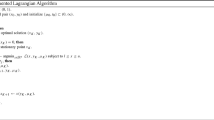Abstract
This paper develops a new error criterion for the approximate minimization of augmented Lagrangian subproblems. This criterion is practical since it is readily testable given only a gradient (or subgradient) of the augmented Lagrangian. It is also “relative” in the sense of relative error criteria for proximal point algorithms: in particular, it uses a single relative tolerance parameter, rather than a summable parameter sequence. Our analysis first describes an abstract version of the criterion within Rockafellar’s general parametric convex duality framework, and proves a global convergence result for the resulting algorithm. Specializing this algorithm to a standard formulation of convex programming produces a version of the classical augmented Lagrangian method with a novel inexact solution condition for the subproblems. Finally, we present computational results drawn from the CUTE test set—including many nonconvex problems—indicating that the approach works well in practice.
Similar content being viewed by others
References
Andreani R., Birgin E.G., Martínez J.M., Schuverdt M.L.: On augmented Lagrangian methods with general lower-level constraints. SIAM J. Optim. 18(4), 1286–1309 (2007)
Andreani R., Birgin E.G., Martínez J.M., Schuverdt M.L.: Augmented Lagrangian methods under the constant positive linear dependence constraint qualification. Math. Program. 111(1–2), 5–32 (2008)
Andreani, R., Haeser, G., Schuverdt, M., Silva, P.J.S.: A relaxed constant positive linear dependence constraint qualification and applications. Math. Program. Published electronically. doi:10.1007/s10107-011-0456-0 (2011)
Andreani, R., Haeser, G., Schuverdt, M., Silva, P.J.S.: Two new weak constraint qualifications and applications. Available at Optimization Online: http://www.optimization-online.org/DB_HTML/2011/07/3105.html (2011)
Bertsekas D.P.: Constrained Optimization and Lagrange Multiplier Methods. Academic Press, New York, NY (1982)
Birgin, E.G., Fernández, D., Martínez, J.M.: On the boundedness of penalty parameters in an augmented Lagrangian method with constrained subproblems. Optim. Meth. Softw. (2012, in press)
Bongartz I., Conn A.R., Gould N., Toint P.L.: CUTE: constrained and unconstrained testing environment. ACM Trans. Math. Softw. 21(1), 123–160 (1995)
Conn A.R., Gould N., Sartenaer A., Toint P.L.: Convergence properties of an augmented Lagrangian algorithm for optimization with a combination of general equality and linear constraints. SIAM J. Optim. 6(3), 674–703 (1996)
Conn A.R., Gould N.I.M., Toint P.L.: A globally convergent augmented Lagrangian algorithm for optimization with general constraints and simple bounds. SIAM J. Numer. Anal. 28(2), 545–572 (1991)
Conn A.R., Gould N.I.M., Toint P.L.: LANCELOT: A Fortran package for Large-Scale Nonlinear Optimization (Release A). Springer, Berlin (1992)
Dolan E.D., Moré J.J.: Benchmarking optimization software with performance profiles. Math. Program. 91(2), 201–213 (2002)
Eckstein J.: A practical general approximation criterion for methods of multipliers based on Bregman distances. Math. Program. 96(1), 61–86 (2003)
Eckstein J., Silva P.J.S.: Proximal methods for nonlinear programming: double regularization and inexact subproblems. Comput. Optim. Appl. 46(2), 279–304 (2010)
Fernández, D., Solodov, M.V.: Local convergence of exact and inexact augmented Lagrangian methods under the second-order sufficient optimality condition. Technical Report A677, Instituto Nacional de Matemática Pura e Aplicada (IMPA), Rio de Janeiro (2011)
Friedlander M.P., Saunders M.A.: A globally convergent linearly constrained Lagrangian method for nonlinear optimization. SIAM J. Optim. 15(3), 863–897 (2005)
Hager, W.W., Zhang, H.: ASA-CG source code. http://www.math.ufl.edu/~hager/papers/CG/
Hager W.W., Zhang H.: A new conjugate gradient method with guaranteed descent and an efficient line search. SIAM J. Optim. 16(1), 170–192 (2005)
Hager W.W., Zhang H.: A new active set algorithm for box constrained optimization. SIAM J. Optim. 17(2), 526–557 (2006)
Jones, E., Oliphant, T., Peterson, P., et al.: SciPy: Open source scientific tools for Python. http://www.scipy.org/ (2001)
Korpelevich G.M.: Extrapolation gradient methods and their relation to modified Lagrange functions. 19(4), 694–703 (1983)
Rockafellar R.T.: Local boundedness of nonlinear, monotone operators. Michigan Math. J. 16, 397–407 (1969)
Rockafellar R.T.: Convex Analysis. Princeton University Press, Princeton, NJ (1970)
Rockafellar R.T.: On the maximality of sums of nonlinear monotone operators. Trans. Am. Math. Soc. 149, 75–88 (1970)
Rockafellar R.T.: Conjugate Duality and Optimization. SIAM, Philadelphia (1974)
Rockafellar R.T.: Augmented Lagrangians and applications of the proximal point algorithm in convex programming. Math. Oper. Res. 1(2), 97–116 (1976)
Rockafellar R.T.: Monotone operators and the proximal point algorithm. SIAM J. Control Optim. 14(5), 877–898 (1976)
Solodov M.V., Svaiter B.F.: A hybrid approximate extragradient-proximal point algorithm using the enlargement of a maximal monotone operator. Set-Valued Anal. 7(4), 323–345 (1999)
Solodov M.V., Svaiter B.F.: A hybrid projection-proximal point algorithm. J. Convex Anal. 6(1), 59–70 (1999)
Solodov M.V., Svaiter B.F.: An inexact hybrid generalized proximal point algorithm and some new results on the theory of Bregman functions. Math. Oper. Res. 25(2), 214–230 (2000)
Spingarn J.E.: Partial inverse of a monotone operator. Appl. Math. Optim. 10(3), 247–265 (1983)
van Rossum, G., et al.: Python language website. http://www.python.org/
Author information
Authors and Affiliations
Corresponding author
Additional information
This material is based in part upon work supported by the National Science Foundation under Grant CCF-1115638. Jonathan Eckstein was also partially supported by Rutgers Business School Research Resources Committee grants. Paulo J. S. Silva was partially supported by CNPq (grants 303030/2007-0 and 474138/2008-9) and PRONEX–Optimization.
Rights and permissions
About this article
Cite this article
Eckstein, J., Silva, P.J.S. A practical relative error criterion for augmented Lagrangians. Math. Program. 141, 319–348 (2013). https://doi.org/10.1007/s10107-012-0528-9
Received:
Accepted:
Published:
Issue Date:
DOI: https://doi.org/10.1007/s10107-012-0528-9



